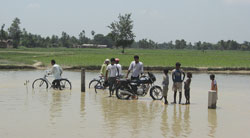|
|
The Madhesi Tigers' five-day banda in central tarai has proved once again that callousness and criminality are the defining features of violent politics everywhere.
Nothing else explains the cruelty of imposing a general shut-down on people struggling to recover from some of the worst floods anyone can remember.
With farmland submerged, the poor and the marginalised were desperate for the work provided by commerce and transport. For them, this man-made disaster was even worse than the natural calamity. But there is more to the crisis in tarai than just politics.
The growing frequency of floods is the result of man's careless intervention in tarai's fragile ecosystem. Apart from global warming, four factors have played a role in the annual devastation.
. Extensive areas of the tarai wetlands, which once absorbed much of the rainfall, have been drained for human settlement in the Bhitri Madhes.
. The vegetation of the Chure Hills, which used to slow the surface run-off and soak up the monsoon downpours, has been cut down and replaced by terraced fields of corn which are repeatedly washed away and rebuilt. The rivers downstream are now so heavily laden with silt and gravel that they burst their banks at the first opportunity.
. The once dense forests of Char Kose Jhadi, which trapped the silt in their tangle of roots and brushwood have now been thinned in the name of community forestry, with its neat and tidy plantations and cleared undergrowth.
. In the neighbouring downstream states of West Bengal, Bihar, and Uttar Pradesh, lines of embankments have begun to restrict the natural flow of the larger rivers. The constricted waterways can no longer contain the swollen rivers of the monsoon season, and create a backfill of water in the upper reaches, where the river banks are unable to contain such a vast volume. The levees may not have benefited Indian farmers much, but they have brought misery to the lives of people in the tarai.
There isn't much that can be undone on the Nepali side of the border to reduce the intensity of floods in the tarai. And we have even less control over the proliferating embankments and dams south of the Dasgaja strip in India, where growing prosperity will probably provoke our neighbours into erecting even higher structures. Catastrophe looms in Nepal's economic powerhouse.
The people of the tarai will have to learn to live with the summer dust bowl, monsoon deluge, and winter haze. We need to study further the processes of tarai's ecological degradation as we cannot deal with future challenges without understanding what has created this crisis in the first place. But there are certain imperatives for the stability of our national political economy that cannot be deferred any longer.
Traditional methods of rice, wheat and pulse cultivation in tarai will become increasingly difficult. Research must begin immediately to develop agricultural practices like the System of Rice Intensification (SRI) more suited to the alternately parched, and soaked landscape. The country's second east-west highway will have to connect the valleys of the Mahabharata ranges further to the north.
To the chagrin of madhesi politicians, industrial activity in Dhangadi, Nepalganj, Bhairawa, Simara, Lahan, and Biratnagar will move to Atariya, Kohalpur, Butwal, Hetauda, Udaypur, or Dharan. The demographic and political ramifications of this slow but massive shift will need to be carefully examined in advance. The warring political factions in the tarai are fighting ghosts of the past. More than fractious politics, it's the ecological crisis that will test the mettle of this country's future leaders.




